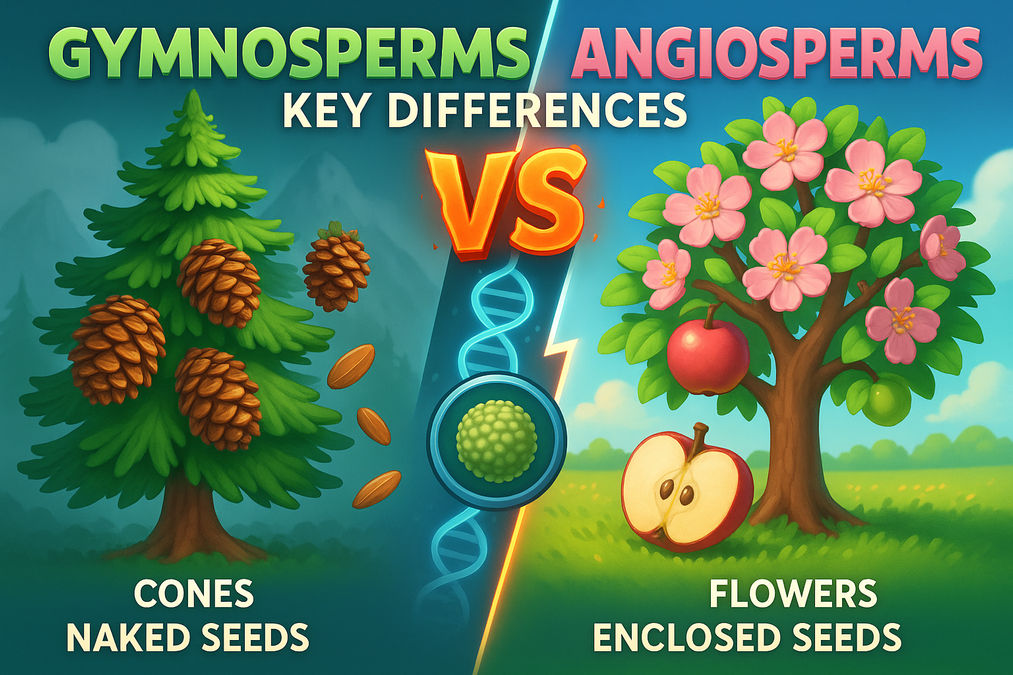Gymnosperms vs Angiosperms: Key Differences

Gymnosperms vs Angiosperms: A Battle of Seed Strategies
Gymnosperms: Masters of Cones
Examples: Pine, Cycas, Ginkgo
Adaptations:
- Needle leaves with thick cuticles (prevents desertification)
- Wind pollination (e.g., pine pollen grains with air sacs)
- Coralloid roots in Cycas host nitrogen-fixing cyanobacteria
Economic Importance
Conifers provide timber (e.g., Cedar), resins (turpentine), and medicinal taxol from yew trees.
Angiosperms: The Flowering Revolution
Examples: Rice (monocot), Rose (dicot)
Evolutionary Edge:
- Double fertilization → Endosperm formation
- Fruit dispersal mechanisms (e.g., animal-borne seeds)
- Co-evolution with pollinators (bees, butterflies)
Monocots vs Dicots
Monocots: Parallel venation, fibrous roots (e.g., wheat)
Dicots: Reticulate venation, taproots (e.g., carrots)
360 MYA
First Gymnosperms
140 MYA
Angiosperms Emerge
FAQs
Q: What is the key structural difference between gymnosperm and angiosperm seeds?
A: Gymnosperm seeds are naked (exposed on cone scales), while angiosperm seeds develop inside ovaries that mature into fruits (e.g., apples, beans).
Q: Why do gymnosperms like Pinus thrive in cold climates?
A: Needle-like leaves reduce water loss, and thick cuticles protect against frost. Their conical shape also sheds snow efficiently.
Q: How do angiosperms achieve "double fertilization"?
A: One sperm fertilizes the egg (forming the zygote), while the other fuses with polar nuclei to create nutrient-rich endosperm (e.g., in wheat grains).
Q: What are coralloid roots in Cycas?
A: Specialized roots that host nitrogen-fixing cyanobacteria, enhancing soil fertility—a unique gymnosperm adaptation.
Q: Why are angiosperms more species-rich than gymnosperms?
A: Flowers attract pollinators (bees, birds), enabling niche specialization. Fruits also aid in diverse seed dispersal (e.g., animal-borne, wind).
Q: Name medicinal products derived from gymnosperms.
A: Taxol (from yew trees) treats cancer, and pine resin is used in antiseptics. Ephedrine (from Ephedra) aids respiratory issues.
Q: How do gymnosperms pollinate without flowers?
A: They rely on wind to carry pollen grains (with air sacs in Pinus) to female cones—a less efficient but ancient strategy.
Q: What makes angiosperm leaves more versatile than gymnosperm needles?
A: Broad leaves (e.g., mango) maximize photosynthesis, while venation supports nutrient transport—key to dominating tropical ecosystems.
Q: Can gymnosperms produce fruits?
A: No. Only angiosperms form fruits. Gymnosperm seeds develop on cone scales (e.g., pine nuts on Pinus female cones).
Q: Why are conifers critical to the timber industry?
A: Their tall, straight trunks (e.g., Cedar, Pine) produce durable wood for construction and paper pulp.
Q: How do monocots and dicots differ in germination?
A: Monocots (e.g., corn) have one seed leaf (cotyledon), while dicots (e.g., beans) have two. This affects early growth patterns.
Q: What evolutionary advantage do flowers provide?
A: Flowers enable co-evolution with pollinators, ensuring targeted pollen transfer and reducing reliance on wind—a key reason for angiosperm dominance.
Join the conversation